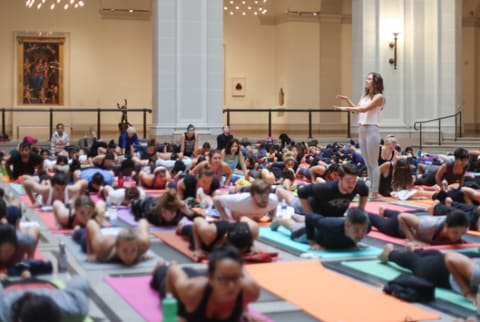Advertisement
Feeling Anxious? This Diaphragmatic Breath Routine Will Chill You Out In Less Than 5 Minutes


When it comes to yoga, Ally Bogard is a teacher's teacher. She's deeply embedded in the yoga community in New York with roots in Canada, her original home. Her poetic way of speaking, challenging sequences, and spot-on intuition draw large, loyal crowds to her weekly classes at SKY TING and Yoga Shanti in New York City and trainings abroad.
Since founding gaiatri, a yoga teacher training program based in Canada, she's made a name for herself within the wellness community as a silent but powerful source of wisdom specifically in the practice of cultivating attention through asana, meditation, yoga Nidra, and breathwork.
One of the most common things she sees and works on with her private clientele and in public classes is anxiety. "We know that someone is going to be in an activated, stressful nervous system and have low-grade anxiety if the belly comes in on an inhale," Bogard said. This is called a reverse breathing pattern and is, perhaps not surprisingly, quite common in today's always-on, digital, social media world.
"The practice of meditation and breathwork engages the subtle body, the intuitive body, the all-knowing body—that part of the body that knows and sees and hears the unseen and the unstruck," Bogard said. These are the things that, by keeping ourselves busy, we tend to push down.
These are the things that grip on our organs, digestion, and musculature when we don't allow them to release. The diaphragm orchestrates a lot of this tension and release, Bogard said. In order to facilitate a diaphragmatic release, try this breathwork routine Borgard teaches often at workshops and trainings.
Activated breath pattern: diaphragmatic breathing.
- Lie down. Keep breathing through your nose, and then deepen it through your lower belly. Your belly should feel like a balloon on the inhale and soften down on the exhale. Do this for 5 or 10 breaths.
- Place your hand on the navel or slightly beneath it. Put a very slight amount of pressure down between the navel and the low belly to encourage the breath into that space. To be clear, this is not the breath going down into the organs but creates an engagement of the thoracic diaphragm down and out.
- Breathe up and into the pressure of the hand through the power of your low belly. This low, deep breathing begins to engage the diaphragm.
- Keeping that hand where it is, slide the other hand to the base of the ribs at the side of the body. Keep the breath low and deepen it so much that it goes wide into your own hand. It's a deep and wide breath. You might start to feel a little bit of a tingle as you start to activate the diaphragm.
- Keep the breath deep and continue to push your hands out wide with the breath. This is the diaphragm starting to unhook itself from stress from the psoas major.
- Bring the hand that's on your lower ribs up to directly below the collarbone. Keeping the deep belly breath, continuing to breathe wide into the lower ribs, start to bring it high into your upper hand. Continue breathing like this: The breath goes deep, wide, then high. On the exhale, allow it to simply and effortlessly fall out of you.
- Turn the three-part breath into one oceanic wave of breath, seamlessly going deep, wide, and high. Continue like this for 10 breaths.
"When you're breathing well, the ocean of the belly and the tide of the breath is a beautiful rhythmic fullness on the inhale and emptiness on the exhale almost purely in the belly," Bogard said.
For more on the healing power of breath, check out this mbg class.
Watch Next
Enjoy some of our favorite clips from classes
Enjoy some of our favorite clips from classes
What Is Meditation?
Mindfulness/Spirituality | Light Watkins
Box Breathing
Mindfulness/Spirituality | Gwen Dittmar
What Breathwork Can Address
Mindfulness/Spirituality | Gwen Dittmar
The 8 Limbs of Yoga - What is Asana?
Yoga | Caley Alyssa
Two Standing Postures to Open Up Tight Hips
Yoga | Caley Alyssa
How Plants Can Optimize Athletic Performance
Nutrition | Rich Roll
What to Eat Before a Workout
Nutrition | Rich Roll
How Ayurveda Helps Us Navigate Modern Life
Nutrition | Sahara Rose
Messages About Love & Relationships
Love & Relationships | Esther Perel
Love Languages
Love & Relationships | Esther Perel

















